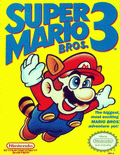
































Super Mario Bros. 3

Super Mario Bros. 3 is a platform video game developed and published by Nintendo for the Famicom/NES, and is the third game in the Super Mario series. The game was released in Japan in 1988, in the United States in 1990, and in Europe in 1991. Development was handled by Nintendo Entertainment Analysis and Development, led by Shigeru Miyamoto, who directed the game along with Takashi Tezuka.
The game focuses on Mario and his brother Luigi, who embark on a quest to save Princess Toadstool and the rulers of seven different kingdoms from the series' primary antagonist, Bowser, and his children, the Koopalings. The two must traverse a total of eight separate regions in order to restore order to
the Mushroom World. Super Mario Bros. 3 builds on the gameplay of previous Mario games by introducing new power-ups used to augment character abilities, establishing several conventions that have also been featured in later titles of the franchise.
Before its North American release, gameplay footage from Super Mario Bros. 3 appeared in the Universal Studios film The Wizard, which helped to fuel anticipation amongst fans. The game was an instant commercial success, ultimately becoming one of the best-selling video games of all time. Super Mario Bros. 3 was also well received by critics and has ranked highly in numerous 'greatest games of all time' lists. The title's popularity resulted in a short-lived animated television show, and it has since been ported to several of Nintendo's later consoles – notably as part of Super Mario All-Stars for the SNES, which featured an updated version that would also subsequently be used for Super Mario Advance 4.
Super Mario Bros. 3 is a two-dimensional, side-scrolling platform game in which the player controls the on-screen protagonist: either Mario or Luigi. The game shares similar gameplay mechanics with previous titles in the series — Super Mario Bros., Super Mario Bros.: The Lost Levels, and Super Mario Bros. 2 — but introduces several new elements. In addition to the running and jumping moves found in past games, the player can slide down slopes, pick up and throw special blocks, and freely climb up and down vines. In addition, with power-ups, Mario can fly and float. The game world consists of eight 'kingdoms' that are each subdivided into multiple levels. The eight worlds feature distinct visual themes; for example, the second world, 'Desert Land', contains sand-covered levels with pyramids, while the levels in the fourth world, 'Giant Land', are populated with obstacles and enemies twice as tall and twice as wide as those in the other worlds.
The player navigates through the game via two game screens: an overworld map and a level play-field. The overworld map displays an overhead representation of the current kingdom and has several paths leading from the world's entrance to a castle. Paths connect to action panels, fortresses and other map icons, and allow players to take different routes to reach the kingdom's goal. Moving the on-screen character to an action panel or fortress will allow access to that level's playfield, a linear stage populated with obstacles and enemies. The majority of the game takes place in these levels, with the player traversing the stage by running, jumping, flying, swimming, and dodging or defeating enemies.
Super Mario Bros. 3 (World map)
Completing stages allows the player to progress through the overworld map and to succeeding worlds. Each world features a final stage with a boss to defeat; the first seven worlds feature an airship controlled by one of the Koopalings, while the player battles Bowser in his castle in the eighth world. Other map icons include large boulders and locked doors that impede paths, and several mini-games that provide the player a chance to obtain special power-ups. Power-ups obtained in these mini-games are stored in a reserve until activated by the player from the map screen.
In addition to special items from previous games like the 'Super Mushroom' and the 'Fire Flower', new power-ups are introduced that provide the player with new options. The 'Super Leaf' and 'Tanooki Suit' give Mario raccoon and tanuki appearances respectively and allow him to fly; the 'Tanooki Suit' also enables him to turn into stone to avoid enemies for a short period of time. Changing into a Tanooki statue while jumping results in Mario pounding the ground and killing whatever enemies are directly under him; this marks the first appearance of the 'ground pound' move in a Mario game, a move that was later given to Yoshi in Super Mario World 2: Yoshi's Island and that later became part of Mario's standard move set in Super Mario 64 and subsequent games. Other suits include the 'Frog Suit', which increases the character's underwater speed and agility and improves jumping height on land, and the 'Hammer Suit', which gives Mario the appearance of the Hammer Bro. enemy and allows him to throw hammers at enemies and resist fire attacks (when crouching).
Super Mario Bros. 3 includes a multiplayer option which allows two players to cooperatively play the game by taking turns at navigating the overworld map and accessing stage levels; the first player controls Mario, while the other controls Luigi (a palette swap of Mario). Through this mode, players can also access several mini-games, including a remake of the original Mario Bros. arcade game, in which one player has the opportunity to steal the cards of another but may lose their turn if they lose the mini-game.
How to play:
Click on the joystick icon in the Super Mario Bros. 3 online emulator to see how to control the Super Mario Bros. 3 game









































Comments